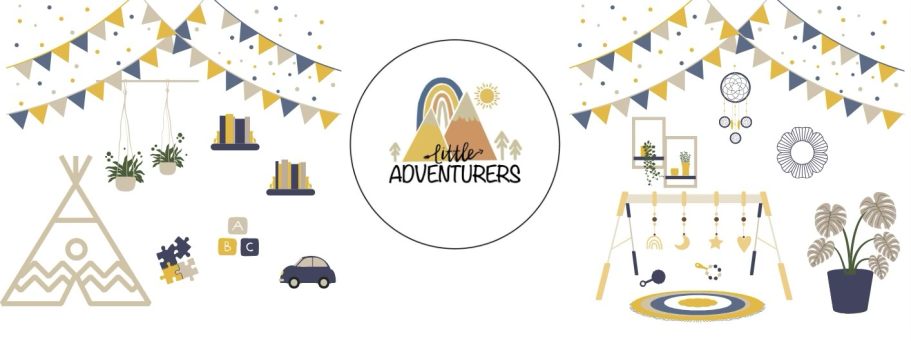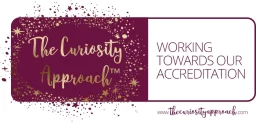Curiosity Approach
Introduction
The Curiosity Approach is a modern-day approach to early years education that fits perfectly in current changing technological times. Bringing curiosity, awe and wonder into early childhood & creating the ‘thinkers & doers’ of the future. As a nursery, we are working towards our accreditation. It is the most exciting journey and we are already seeing the most remarkable impact on the way we teach, and the way children learn in our nursery. It provides our team with an embedded, strong vision and shared purpose for what we do here at Little Adventurers Day Nursery.
But it’s too beautiful and homely to be a nursery!
We hear this so often. Why should our children be provided with anything less than beautiful and homely? They are after all still babies and children, and home is what they are familiar with. Much of the curiosity accreditation is about reflecting on our environment and looking at it through the eyes of a child. Are there natural elements such as plants throughout? Are there cosy, inviting spaces for children to snuggle up? Is there soft, calm lighting throughout? Have soft furnishings such as rugs, cushions, drapes been used to soften the environment?
Where are all the toys?
We live in a fast-paced world that has been consumed with technology, which carries out tasks for us at the touch of a button. Think back to your childhood. How much of it did you spend sat playing on an electronic device? Not much I bet. How much of it did you spend building dens; getting muddy; exploring the trinkets at granny’s house? Did you have the bright plastic toys, with their flashing lights and noisy buttons that our children have now-a-days? No. You probably had wooden building blocks.
There has been a gradual but significant shift due to the hectic, demanding lifestyles of parents. Manufacturers of toys now produce toys and equipment for children that entertain them. Children press a button and get an immediate output from a toy. The child is not required to actively engage; or problem solve; or think critically. At Little Adventurers we work on the theory that the more a toy does, the less the child learns from it. So, based on this knowledge, our children do not play with plastic manufactured toys.
Much of the equipment and resources that we use in the nursery is real-life, adult sized. For example, in our home corner kitchens, children have full-sized real pots and pans. They have a vase of flowers set on their lunch table to give that homely feel. Why? Because after years of watching children disrespect, drop and throw plastic toy ones, and considering carefully why this is, it dawned on us that there is no consequence to dropping plastic.
So, through the curiosity approach and our research, we introduced real breakable ceramics and were blown away with the results. We now observe children demonstrating such respectful, careful behaviour towards their environment. Very seldom do things get broken, and when they do, that’s ok because children learn from it, clear it up and as a result they are more careful from then on.
Loose parts and Open-ended Resources
Ever marvelled at the long hours’ children can spend playing with simple materials like boxes, rocks, shells, sand, or water? As you will have noted yourself, children are often more interested in the packaging than in the toys themselves.
Children usually prefer play that stimulates their curiosity and gives free reign to their imaginations and creativity. We believe that one of the best ways to enhance their natural curiosity is to introduce a wide variety of the materials we call “loose parts” into their play.
At Little Adventurers, loose parts mean alluring, beautiful, found objects and materials that children can move, manipulate, control, and change while they play. Children can carry, combine, redesign, line up, take apart, and put loose parts back together in almost endless ways. The materials come with no specific set of directions, and they can be used alone or combined with other materials. Children can turn them into whatever they desire: a stone can become a character in a story; an acorn can become an ingredient in an imaginary soup. These objects invite conversations and interactions, and they encourage collaboration and cooperation.
Loose parts possess infinite play possibilities. They offer multiple rather than single outcomes: no specific set of directions accompanies them; no single result is inevitable. Unlike a jigsaw puzzle, whose pieces are meant to be fitted together in a specific way to make a single picture, loose parts can be joined in many ways.
Anyone who has watched children play with toys knows that they quickly tire of things with a sole purpose. Once they’ve mastered the key function of an object—pushing the button to make a figure pop up or climbing a ladder, for example—they are ready to move on. The intrigue and the challenge are gone. In other words, children make their play choices based on how much variability those materials offer. A stick is a richer choice than a slide because it can become a fishing pole, a spoon for stirring a concoction, a magic wand.

Mindful, attentive adults
Having a beautiful environment is one thing, but on its own its not enough. We have a team of empowered and passionate practitioners. Too often early years settings are over-looked, undermined, and undervalued; viewed as baby-sitting services. It is a personal and long-standing bugbear. Many of our team are qualified to degree level, and possess a deep wealth of knowledge about how children learn.
Adults play and interact mindfully alongside children, knowing when to use questions, or narrative to support children’s ideas. Sometimes sitting back and just allowing children’s play to evolve is the most effective method. They are always present and in the moment with children, not by-standers simply supervising.
Curious?
If the above brief outline of our approach has made you curious, imagine what a day in one of our nurseries does for our children!
Click here to discover more about the Curiosity Approach Curiosity Parent Page
Click here to download our parents guide to the EYFS (Early Years Foundation Stage) EYFS Parent Guide
We need your consent to load the translations
We use a third-party service to translate the website content that may collect data about your activity. Please review the details in the privacy policy and accept the service to view the translations.

